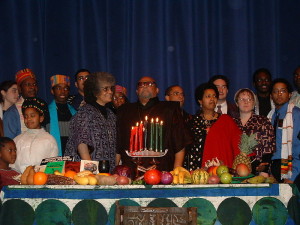 Kwanzaa is a week-long celebration held in the United States (and, more recently, Canada) but also celebrated in the Western African Diaspora. The celebration honors African heritage in African-American culture, and is observed from December 26 to January 1, culminating in a feast and gift-giving. Kwanzaa has seven core principles (Nguzo Saba): Unity, self-determination, collective work and responsibility, cooperative economics, purpose, creativity, and faith. It was created by Maulana Karenga, and was first celebrated in 1966–67.
Kwanzaa is a week-long celebration held in the United States (and, more recently, Canada) but also celebrated in the Western African Diaspora. The celebration honors African heritage in African-American culture, and is observed from December 26 to January 1, culminating in a feast and gift-giving. Kwanzaa has seven core principles (Nguzo Saba): Unity, self-determination, collective work and responsibility, cooperative economics, purpose, creativity, and faith. It was created by Maulana Karenga, and was first celebrated in 1966–67.
History and etymology
Maulana Karenga created Kwanzaa in 1966 as the first specifically African-American holiday. Karenga said his goal was to “give Blacks an alternative to the existing holiday and give Blacks an opportunity to celebrate themselves and their history, rather than simply imitate the practice of the dominant society.”[citation needed]The name Kwanzaa derives from the Swahili phrase matunda ya kwanza, meaning first fruits of the harvest.[citation needed] The choice of Swahili, an East African language, reflects its status as a symbol of Pan-Africanism, especially in the 1960s, despite the fact that most East African nations were not involved in the Atlantic slave trade that brought African people to America.
Kwanzaa was a celebration that has its roots in the black nationalist movement of the 1960s, and was established as a means to help African Americans reconnect with their African cultural and historical heritage by uniting in meditation and study of African traditions and Nguzu Saba, the “seven principles of African Heritage” which Karenga said “is a communitarian African philosophy”.
During the early years of Kwanzaa, Karenga said that it was meant to be an alternative to Christmas, that Jesus was psychotic, and that Christianity was a white religion which black people should shun. However, as Kwanzaa gained mainstream adherents, Karenga altered his position so that practicing Christians would not be alienated, then stating in the 1997 Kwanzaa: A Celebration of Family, Community, and Culture, “Kwanzaa was not created to give people an alternative to their own religion or religious holiday.”
Many Christian African Americans who celebrate Kwanzaa do so in addition to observing Christmas.
Principles and symbols
Kwanzaa celebrates what its founder called the seven principles of Kwanzaa, or Nguzo Saba (originally Nguzu Saba—the seven principles of African Heritage), which Karenga said “is a communitarian African philosophy,” consisting of what Karenga called “the best of African thought and practice in constant exchange with the world.” These seven principles comprise *Kawaida, a Swahili term for tradition and reason. Each of the seven days of Kwanzaa is dedicated to one of the following principles, as follows:
- Umoja (Unity): To strive for and to maintain unity in the family, community, nation, and race.
- Kujichagulia (Self-Determination): To define ourselves, name ourselves, create for ourselves, and speak for ourselves.
- Ujima (Collective Work and Responsibility): To build and maintain our community together and make our brothers’ and sisters’ problems our problems, and to solve them together.
- Ujamaa (Cooperative Economics): To build and maintain our own stores, shops, and other businesses and to profit from them together.
- Nia (Purpose): To make our collective vocation the building and developing of our community in order to restore our people to their traditional greatness.
- Kuumba (Creativity): To do always as much as we can, in the way we can, in order to leave our community more beautiful and beneficial than we inherited it.
- Imani (Faith): To believe with all our hearts in God, our people, our parents, our teachers, our leaders, and the righteousness and victory of our struggle.
Kwanzaa symbols include a decorative mat on which other symbols are placed, corn and other crops, a candle holder with seven candles, called a kinara, a communal cup for pouring libations, gifts, a poster of the seven principles, and a black, red, and green flag. The symbols were designed to convey the seven principles.

